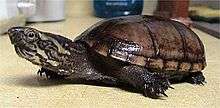Eastern mud turtle
| Eastern mud turtle | |
|---|---|
 | |
| Kinosternon subrubrum | |
| Scientific classification | |
| Kingdom: | Animalia |
| Phylum: | Chordata |
| Class: | Reptilia |
| Order: | Testudines |
| Suborder: | Cryptodira |
| Family: | Kinosternidae |
| Genus: | Kinosternon |
| Species: | K. subrubrum |
| Binomial name | |
| Kinosternon subrubrum (Bonnaterre, 1789)[2] | |
| Synonyms[3] | |
| |
The Eastern mud turtle (Kinosternon subrubrum) or common mud turtle[2] is a common species of turtle endemic to the United States.
Description
The Eastern mud turtle is a small and often hard to identify species. It measures 3–4 in (7.6–10.2 cm) in carapace length. The carapace is keelless, lacks any pattern, and varies in color from yellowish to black. The plastron is large and double hinged, and can be yellowish to brown, and may sometimes have a dark pattern. The chin and throat are a yellowish grey, streaked and mottled with brown, while the limbs and tail are grayish. The eye, or iris, of the Eastern mud turtle is yellow with dark clouding, and its feet are webbed.
Habitat
Mud turtles are fresh water turtles that are found in the southern United States. They live in rivers, lakes and swamps. Mud Turtles prefer ponds that have a lot of vegetation. These animals can generally be found in spring-fed streams, and they prefer clean, oxygenated water. In the wild, they also prefer sandy and muddy areas, as they will hibernate by burrowing into the mud.
Diet
K. subrubrum feeds mainly on insects and small fish, however, Mud Turtles are omnivorous, and will eat a variety of foods, including snails, insects, fish, various worms, and dark leafy greens.
Reproduction
Mating occurs in K. subrubrum during early spring followed by egg laying in May to early June.[4] Clutch sizes vary from 2 to 5.
Threats
Raccoons are known to eat this species' eggs, while herons and alligators often hunt the adults. This species is also exploited by the pet trade.
Geographic range
Eastern mud turtles are found in the US states of Alabama, Arkansas, Delaware, Florida, Georgia, Illinois, Indiana, Kentucky, Louisiana, Maryland, Mississippi, Missouri, New Jersey, New York, North Carolina, Oklahoma, Pennsylvania, South Carolina, Tennessee, Texas, and Virginia.[2]
In Indiana, the Eastern mud turtle is listed as an endangered species.[5]
Subspecies
Three subspecies are recognized as being valid.[2][6]
- K. s. subrubrum (Bonnaterre, 1789) – Eastern mud turtle (nominate subspecies)
- K. s. hippocrepis Gray, 1855 – Mississippi mud turtle
- K. s. steindachneri (Siebenrock, 1906) – Florida mud turtle
Nota bene: A trinomial authority in parentheses indicates that the subspecies was originally described in a genus other than Kinosternon.
Etymology
The subspecific name, steindachneri, is in honor of Austrian herpetologist Franz Steindachner.[7]
References
- ↑ van Dijk, P.P. (2011). "Kinosternon substratum". The IUCN Red List of Threatened Species. IUCN. 2011: e.T163435A97382608. doi:10.2305/IUCN.UK.2011-1.RLTS.T163435A5606303.en. Retrieved 10 November 2017.
- 1 2 3 4 Rhodin, Anders G.J.; van Dijk, Peter Paul; Iverson, John B.; Shaffer, H. Bradley (2010-12-14). "Turtles of the world, 2010 update: Annotated checklist of taxonomy, synonymy, distribution and conservation status" (PDF). Chelonian Research Monographs. 5: 000.98. doi:10.3854/crm.5.000.checklist.v3.2010. Archived from the original (PDF) on 2010-12-15.
- ↑ Fritz, Uwe; Havaš, Peter (2007). "Checklist of Chelonians of the World" (PDF). Vertebrate Zoology. 57 (2): 259–260. ISSN 1864-5755. Archived from the original (PDF) on 2010-12-17. Retrieved 29 May 2012.
- ↑ Gibbons, J. Whitfield (1983). "Reproductive Characteristics and Ecology of the Mud Turtle, Kinosternon subrubrum (Lacepede)". Herpetologica. 39 (3): 254–271. JSTOR 3892569.
- ↑ Indiana Legislative Services Agency (2011), "312 IAC 9-5-4: Endangered species of reptiles and amphibians", Indiana Administrative Code, retrieved 28 Apr 2012 .
- ↑ "Kinosternon subrubrum ". The Reptile Database. www.reptile-database.org.
- ↑ Beolens, Bo; Watkins, Michael; Grayson, Michael (2011). The Eponym Dictionary of Reptiles. Baltimore: Johns Hopkins University Press. xiii + 296 pp. ISBN 978-1-4214-0135-5. (Kinosternon subrubrum steindachneri, p. 252).
Further reading
- Behler JL, King FW (1979). The Audubon Society Field Guide to North American Reptiles and Amphibians. New York: Knopf. 742 pp. ISBN 0-394-50824-6. (Kinosternon subrubrum, pp. 441–442 + Plates 318, 320, 321).
- Bonnaterre PJ (1789). Tableau encyclopédique et méthodique des trois règnes de la nature, Erpétologie. Paris: Panckoucke. xxviii + 71 pp. + 66 plates. (Testudo subrubra, new species, pp. 27–28 + [turtles] Plate 5, figure 1). (in French and Latin).
- Boulenger GA (1889). Catalogue of the Chelonians, Rhynchocephalians, and Crodcodiles in the British Museum (Natural History). New Edition. London: Trustees of the British Museum (Natural History). (Taylor and Francis, printers). x + 311 pp. + Plates I-III. (Cinosternon pensylvanicum, pp. 39–40).
- Conant R (1975). A Field Guide to Reptiles and Amphibians of Eastern and Central North America, Second Edition. Boston: Houghton Mifflin. xviii + 429 pp. + Plates 1-48. ISBN 0-395-19979-4 (hardcover), ISBN 0-395-19977-8 (paperback). (Kinosternon subrubrum subrubrum, p. 43 + Plates 4, 5 + Map 13).
- Goin CJ, Goin OB, Zug GR (1978). Introduction to Herpetology, Third Edition. San Francisco: W.H. Freeman. xi + 378 pp. ISBN 0-7167-0020-4. (Kinosternon s. subrubrum, detailed description of nesting, p. 264).
- Smith HM, Brodie ED Jr (1982). Reptiles of North America: A Guide to Field Identification. New York: Golden Press. 240 pp. ISBN 0-307-13666-3. (Kinosternon subrubrum, pp. 26–27).
- Stejneger L, Barbour T (1917). A Check List of North American Amphibians and Reptiles. Cambridge, Massachusetts: Harvard University Press. 125 pp. (Kinosternon subrubrum subrubrum, p. 112).
- Zim HS, Smith HM (1956). Reptiles and Amphibians: A Guide to Familiar American Species: A Golden Nature Guide. New York: Simon and Schuster. 160 pp. (Kinosternon subrubrum subrubrum, pp. 19, 23, 155).
External links
- Eastern mud turtle - Kinosternon subrubrum Species account from the Towson University Reptiles of Maryland Web Page.
